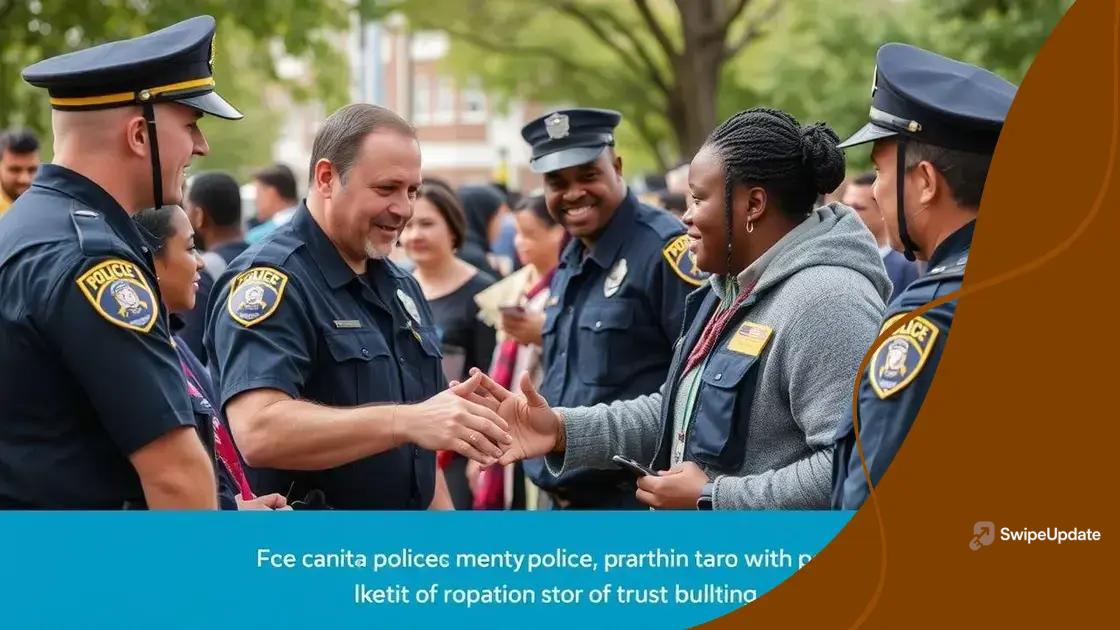Discussions on police reform: What you need to know

The future of police reform in America focuses on enhancing accountability, strengthening community relationships, and utilizing technology to build trust and improve policing practices.
Discussions on police reform are gaining momentum as communities seek more effective and accountable law enforcement. With recent events shining a light on policing practices, it’s essential to understand the complexities involved and how reform can pave the way for a more just society.
Understanding the need for police reform
Understanding the need for police reform is crucial in today’s society. Many communities are facing challenges that can only be addressed through systematic change. The demand for reform stems from concerns about accountability, transparency, and community relations.
Why Police Reform is Essential
Historically, policing practices have often prioritized law enforcement over community safety. This has led to distrust between law enforcement and the communities they serve. Recognizing this need for reform can help to foster collaboration and ensure public safety.
- Accountability measures can establish trust.
- Transparent policies encourage community engagement.
- Bridging gaps between police and community members is vital.
In many cities, residents have raised their voices regarding police practices. For instance, incidents involving excessive use of force have ignited protests and demands for action. These events have highlighted the urgent need for re-evaluation of police strategies and practices.
Community Engagement in Reform
One of the key components of successful police reform is community involvement. When communities are engaged in discussions about policing, it empowers residents and enables a shared vision for safety. Initiatives that incorporate feedback from community members can lead to more effective policing strategies.
- Community forums can facilitate open dialogue.
- Listening to diverse perspectives is invaluable.
- Collaborative training for police and community members can build stronger relationships.
Through community engagement, law enforcement can better understand local concerns, leading to a more effective and responsive policing approach. As society evolves, so must policing practices to reflect the values and expectations of the people they serve. Building a safer community through collaboration is achievable with a clear focus on the need for reform.
Key issues in current police practices
There are several key issues in current police practices that have become focal points for discussions around reform. Many of these issues stem from a combination of historical practices and evolving societal expectations. Highlighting these challenges is critical for understanding the need for change.
Excessive Use of Force
One major concern is the excessive use of force by police. This has been spotlighted by various incidents that sparked public outrage and calls for justice. Addressing this problem can help restore trust between law enforcement and communities.
- Inappropriate responses to non-violent situations.
- Training failures on de-escalation tactics.
- Disproportionate impacts on marginalized groups.
Another issue is racial profiling, where individuals are targeted based on race rather than behavior. This practice not only breeds mistrust but also perpetuates systemic inequality. Awareness and action against racial profiling must be prioritized in contemporary policing.
Lack of Accountability
A lack of accountability within police departments can also lead to serious issues. When officers are not held responsible for their actions, it damages community trust and morale. Implementing stronger accountability measures can create a culture of responsibility within law enforcement.
- Clear guidelines for disciplinary actions.
- Independent oversight boards to evaluate actions.
- Community transparency in investigations.
Additionally, inadequate training is a recurring theme in criticisms of police practices. Officers may not receive the necessary training on mental health crises or conflict resolution, impacting their ability to effectively serve the community. A focus on comprehensive training programs can help address these gaps, promoting better interactions with the community.
Overall, understanding these key issues in current police practices is essential for initiating meaningful reform. By addressing these concerns, law enforcement can move towards a more effective and trusted system that serves all communities fairly.
Successful examples of reform initiatives

There are many successful examples of reform initiatives that highlight the potential for positive change in policing practices. These initiatives demonstrate how communities and law enforcement can work together to create a more just and effective policing system.
Community Policing Programs
One effective approach is the implementation of community policing programs. These programs focus on building partnerships between police and community members. By fostering communication and collaboration, these initiatives help to build trust and improve public safety.
- Police officers engage with residents through regular meetings.
- Community events allow for positive interactions.
- Feedback from residents guides policing strategies.
Another successful example is the development of training programs that emphasize de-escalation techniques. This training helps officers learn how to peacefully resolve conflicts. Focusing on communication skills rather than force is crucial for improving community relations.
Policy Changes and Oversight
Implementing policy changes is also vital for successful reform. Establishing strong oversight committees enables communities to have a say in police practices. This ensures that officers are held accountable for their actions, leading to increased transparency.
- Independent review boards evaluate incidents involving use of force.
- Clear policies are established for officers regarding conduct.
- Periodic audits of police practices can identify areas for improvement.
In some areas, cities have adopted new technology to enhance accountability. Body-worn cameras are one tool that has shown promise. These cameras can provide valuable evidence during incidents, encouraging both police and community members to act respectfully.
Overall, exploring these successful examples of reform initiatives illustrates the potential for positive changes in policing. When communities and law enforcement come together with a shared vision, they can create a safer and more equitable environment for everyone.
Community involvement in policing
Community involvement in policing plays a vital role in building trust and improving relationships between law enforcement and residents. Engaging the community ensures that policing reflects the needs and concerns of the people it serves. Collaborative efforts foster a sense of ownership and responsibility among community members.
Building Trust Through Engagement
One key aspect of community involvement is open communication. Police can hold regular meetings with residents to discuss concerns and share information. This transparency builds trust, making it easier for community members to voice their needs.
- Community forums provide a platform for dialogue.
- Neighborhood watch programs encourage local participation.
- Police can seek input on policy changes from community members.
Another method to encourage involvement is through partnerships with local organizations. When police work alongside community groups, they can better understand the unique needs of their neighborhoods. These partnerships can support initiatives that address local challenges.
Community Policing Strategies
Community policing strategies are designed to enhance connections between police officers and the public. By assigning officers to specific neighborhoods, they can build relationships with residents. Familiarity helps officers gain a deeper understanding of the community.
- Officers can attend local events and celebrations.
- Programs that encourage youth engagement can foster positive relationships.
- Regular patrols in specific areas can provide visibility and reassurance.
Engaging with schools and youth organizations creates opportunities for positive interactions. Providing educational workshops about safety and the role of law enforcement can inform young people and build mutual respect. Community involvement leads to shared goals, making neighborhoods safer and more united.
Overall, community involvement in policing is essential for creating effective law enforcement strategies. By focusing on collaboration and communication, police can foster stronger connections with the people they serve, ensuring that everyone feels heard and valued.
Future of police reform in America
The future of police reform in America holds significant potential as communities and law enforcement agencies seek to address long-standing issues. As awareness grows about the need for change, many cities are developing innovative approaches to improve police practices and community relations.
Emphasis on Accountability
One clear trend is the increasing emphasis on accountability. Many departments are adopting measures that ensure police officers are held responsible for their actions. This includes establishing independent review boards and implementing use-of-force policies that require transparency. By having clear procedures in place, officers can be held accountable, fostering public trust.
- Independent oversight to investigate complaints against officers.
- Regular reviews of police practices to identify areas for improvement.
- Increased transparency in disciplinary actions taken against officers.
Furthermore, technology plays a crucial role in the future of policing. The use of body cameras and data analytics can provide valuable insights into police interactions with the community. These tools can enhance accountability and help identify patterns that need addressing.
Strengthening Community Relationships
Another vital aspect of future reform is strengthening community relationships. Programs that promote collaboration between police and residents are essential for effective policing. By engaging community members in discussions about their needs, police can tailor their approaches to better serve the public.
- Community forums for open dialogue between police and residents.
- Partnerships with local organizations to address specific needs.
- Community-led initiatives that empower residents to take active roles.
Moving forward, additional training focused on de-escalation and cultural competence can also improve police-community interactions. Officers who understand the diverse communities they serve can respond more effectively and compassionately.
Overall, the future of police reform in America is looking towards a collaborative approach that prioritizes accountability, transparency, and community engagement. As these changes take root, the goal is to create a safer and more equitable environment for all citizens.
FAQ – Frequently Asked Questions About Police Reform in America
Why is accountability important in police reform?
Accountability ensures that police officers are responsible for their actions, which helps build trust with the community and can prevent misconduct.
How can community involvement improve policing?
Community involvement allows for better communication and understanding between police and residents, ensuring that policing reflects community needs and values.
What role does technology play in police reform?
Technology, such as body cameras, enhances transparency and accountability, providing valuable data to help improve police-community interactions.
What are the benefits of community policing strategies?
Community policing strategies foster closer relationships between police and residents, leading to increased safety and cooperation in addressing local issues.
